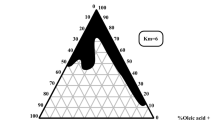Abstract
The development of alternative therapeutic approaches for cutaneous leishmaniasis (CL) has received considerable attention in recent research, including the identification of formulations for topical treatment. In the present study, the activity of two formulations was evaluated in BALB/c mice experimentally infected with either Leishmania (Leishmania) major or L. (L.) amazonensis, a hydrophilic gel containing 10% paromomycin (PAHG) and a cream containing 1% fluconazole (FLUC). After development of ulcerated lesions, infected mice were divided into three groups of five animals each: (1) PA group: Lesions were covered with 50 μl of PAHG; (2) FLUC group: Lesions were covered with 50 μl of FLUC, and (3) placebo group: treated with gel without paromomycin. During and after treatment, the size of lesions was determined weekly using a caliper. The efficacy of PAHG was significantly higher than that observed for FLUC for both Leishmania species. The PAHG formulation was effective in promoting the healing of ulcers in all animals 28 days after the beginning of treatment, whereas none of the animals was cured by FLUC. These results suggest that the PAHG formulation could be suitable for clinical studies and may represent an alternative formulation for the topical treatment of CL.



Similar content being viewed by others
References
Al-Abdely HM, Graybill JR, Loebenberg D, Melby PC (1999) Efficacy of the triazole SCH 56592 against Leishmania amazonensis and Leishmania donovani in experimental murine cutaneous and visceral leishmaniases. Antimicrob Agents Chemother 43:2910–2914
Alrajhi AA, Ibrahim EA, De Vol EB, Khairat M, Faris RM, Maguire JH (2002) Fluconazole for the treatment of cutaneous leishmaniasis caused by Leishmania major. N Engl J Med 346:891–895
Arana BA, Mendoza CE, Rizzo NR, Kroeger A (2001a) Randomized, controlled, double-blind trial of topical treatment of cutaneous leishmaniasis with paromomycin plus methylbenzethonium chloride ointment in Guatemala. Am J Trop Med Hyg 65:466–470
Arana B, Rizzo N, Diaz A (2001b) Chemotherapy of cutaneous leishmaniasis: a review. Med Microbiol Immunol 190:93–95
Armijos RX, Weigel MM, Calvopina M, Mancheno M, Rodriguez R (2004) Comparison of the effectiveness of two topical paromomycin treatments versus meglumine antimoniate for New World cutaneous leishmaniasis. Acta Trop 91:153–160
Ayub AC, Gomes ADM, Lima MVC, Vianna-Soares CD, Ferreira LAM (2006) Topical delivery of fluconazole: in vitro skin penetration and permeation using emulsions as dosage forms. Drug Dev Ind Pharm (in press)
Baron S, Laube S, Raafat F, Moss C (2004) Cutaneous leishmaniasis in a Kosovan child treated with oral fluconazole. Clin Exp Dermatol 29:546–547
Barral-Netto M, Barral A, Brodskyn C, Carvalho EM, Reed SG (1995) Cytotoxicity in human mucosal and cutaneous leishmaniasis. Parasite Immunol 17:21–28
Berman J (1997) Human leishmaniasis: clinical, diagnostic, and chemotherapeutic developments in the last 10 years. Clin Infect Dis 24:684–703
Berman J (2003) Current treatment approaches to leishmaniasis. Curr Opin Infect Dis 16:397–401
Berman J (2005a) Recent developments in leishmaniasis: epidemiology, diagnosis, and treatment. Curr Infect Dis Rep 7:33–38
Berman J (2005b) Clinical status of agents being developed for leishmaniasis. Expert Opin Investig Drugs 14:1337–1346
Castro GA, Nascimento DS, Nunan EA, Fernandes AP, Ferreira LAM (2003) In vitro skin permeation of paromomycin from topical formulations across normal and stripped hairless mouse skin. STP Pharma Sci 13:203–208
Croft SL, Coombs GH (2003) Leishmaniasis—current chemotherapy and recent advances in the search for novel drugs. Trends Parasitol 19:502–508
Croft SL, Seifert K, Yardley V (2006) Current scenario of drug development for leishmaniasis. Indian J Med Res 123:399–410
El-On J, Jacobs GP, Weinrauch L (1988) Topical chemotherapy of cutaneous leishmaniasis. Parasitol Today 4:76–81
Fernandes AP, Carvalho FA, Tavares CA, Santiago HC, Castro GA, Tafuri WL, Ferreira LA, Gazzinelli RT (2001) Combined interleukin-12 and topical chemotherapy for established leishmaniasis drastically reduces tissue parasitism and relapses in susceptible mice. J Infect Dis 183:1646–1652
Grevelink SA, Lerner EA (1996) Leishmaniasis. J Am Acad Dermatol 34:257–272
Goncalves GS, Fernandes AP, Souza RC, Cardoso JE, de Oliveira-Silva F, Maciel FC, Rabello A, Ferreira LA (2005) Activity of a paromomycin hydrophilic formulation for topical treatment of infections by Leishmania (Leishmania) amazonensis and Leishmania (Viannia) braziliensis. Acta Trop 93:161–167
Grogl M, Schuster BG, Ellis WY, Berman JD (1999) Successful topical treatment of murine cutaneous leishmaniasis with a combination of paromomycin (Aminosidine) and gentamicin. J Parasitol 85:354–359
Laffitte E, Genton B, Panizzon RG (2005) Cutaneous leishmaniasis caused by Leishmania tropica: treatment with oral fluconazole. Dermatology 210:249–251
Neal RA, Allen S, McCoy N, Olliaro P, Croft SL (1995) The sensitivity of Leishmania species to aminosidine. J Antimicrob Chemother 35:577–584
Romero GA, Guerra MV, Paes MG, Macedo VO (2001) Comparison of cutaneous leishmaniasis due to Leishmania (Viannia) braziliensis and L. (V.) guyanensis in Brazil: therapeutic response to meglumine antimoniate. Am J Trop Med Hyg 65:456–465
Soto J, Fuya P, Herrera R, Berman J (1998) Topical paromomycin/methylbenzethonium chloride plus parenteral meglumine antimonate as treatment for American cutaneous leishmaniasis: controlled study. Clin Infect Dis 26:56–58
Soto J, Toledo JT, Gutierrez P, Arboleda M, Nicholls RS, Padilla JR, Berman JD, English CK, Grogl M (2002) Treatment of cutaneous leishmaniasis with a topical antileishmanial drug (WR279396): phase 2 pilot study. Am J Trop Med Hyg 66:147–151
Sundar S (2001) Treatment of visceral leishmaniasis. Med Microbiol Immunol 190:89–92
Wortmann G, Miller RS, Oster C, Jackson J, Aronson N (2002) A randomized, double-blind study of the efficacy of a 10 or 20-day course of sodium stibogluconate for treatment of cutaneous leishmaniasis in United States military personnel. Clin Infect Dis 35:261–267
Acknowledgment
This work received financial support from Fundação de Amparo à Pesquisa do Estado de Minas Gerais (FAPEMIG), CNPq and FUNDEP (UMFG). We declare that the experiments performed and presented in this report comply with the laws of the Federal Republic of Brazil.
Author information
Authors and Affiliations
Corresponding author
Rights and permissions
About this article
Cite this article
Mussi, S.V., Fernandes, A.P. & Ferreira, L.A.M. Comparative study of the efficacy of formulations containing fluconazole or paromomycin for topical treatment of infections by Leishmania (Leishmania) major and Leishmania (Leishmania) amazonensis . Parasitol Res 100, 1221–1226 (2007). https://doi.org/10.1007/s00436-006-0394-6
Received:
Accepted:
Published:
Issue Date:
DOI: https://doi.org/10.1007/s00436-006-0394-6




